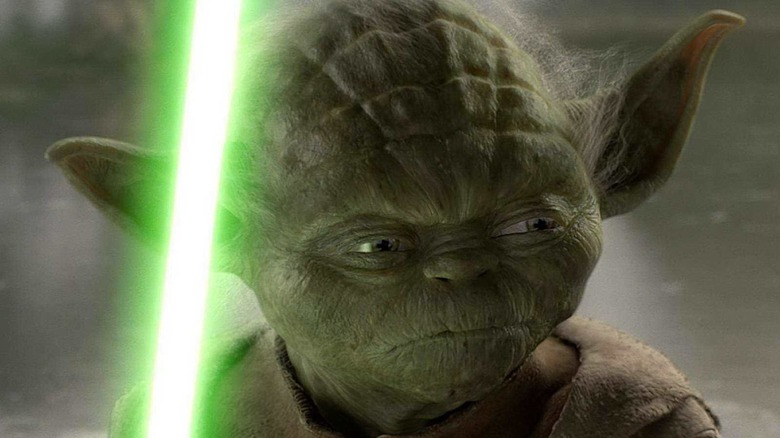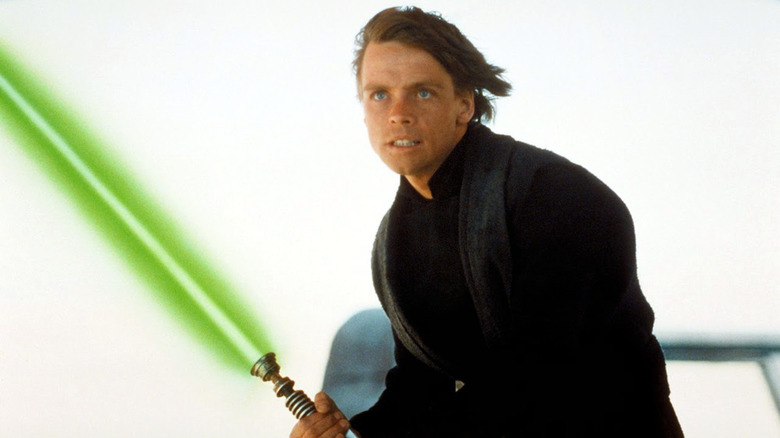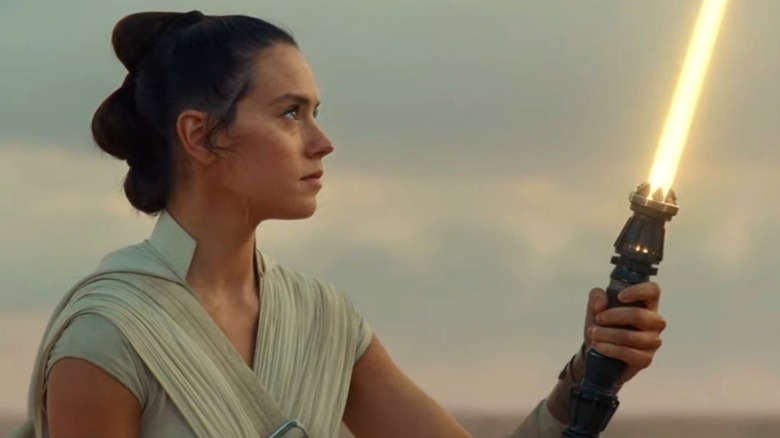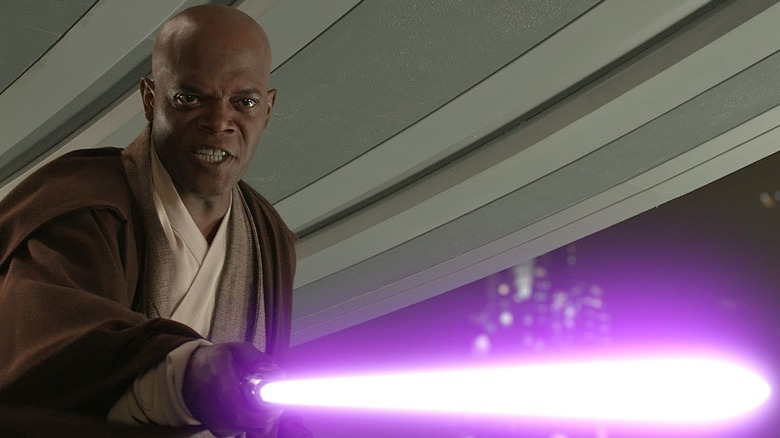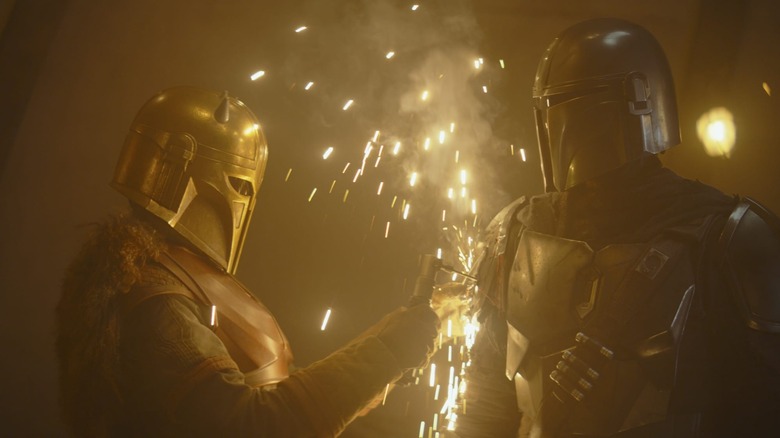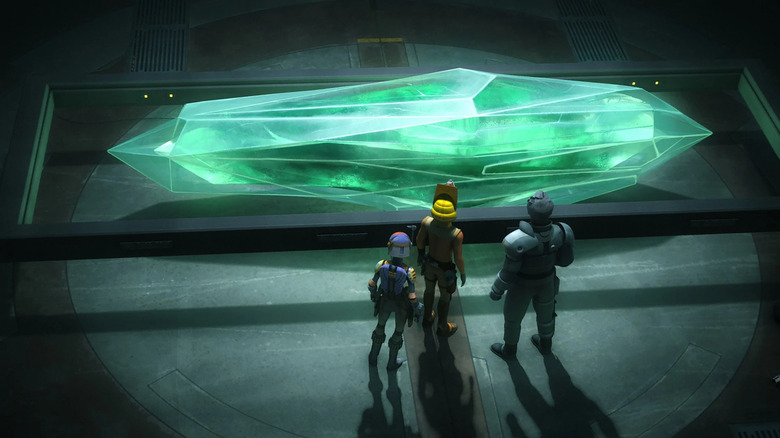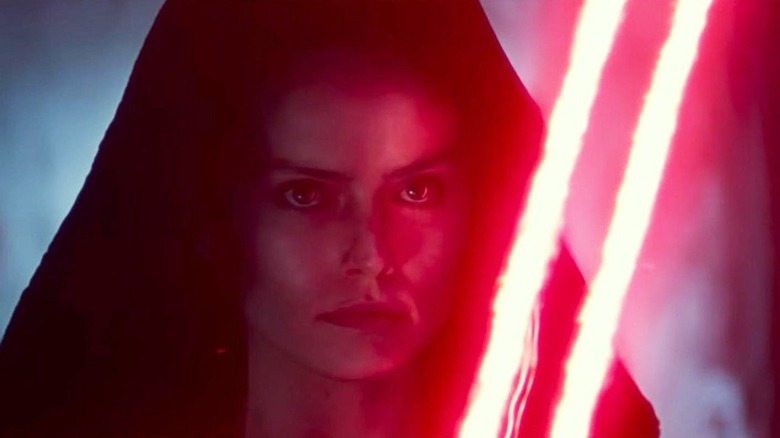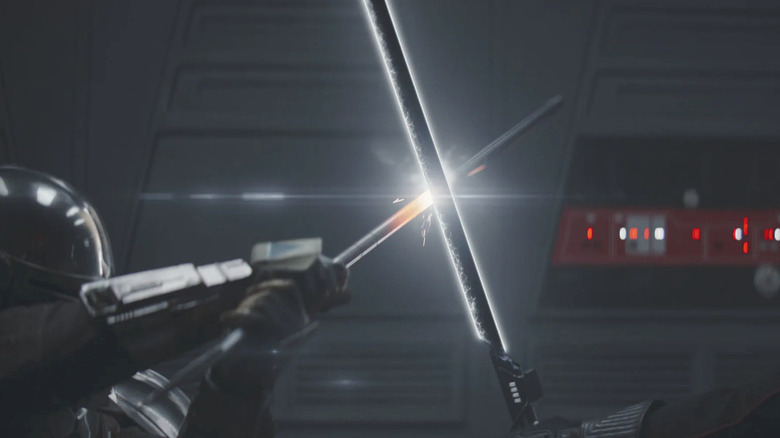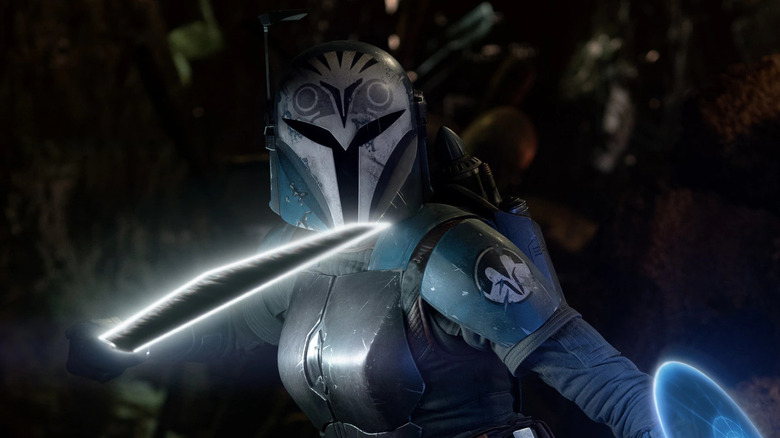Lightsaber Rules That Make No Sense In Star Wars
One of the most indelible and iconic parts of the "Star Wars" movies is the lightsaber, the main weapon utilized by the Jedi and the Sith. With their metal hilts and glowing, colorful blades, lightsabers have arguably become the most famous sci-fi weapons of all time. However, across the many iterations of "Star Wars," there have been some disputable rules and questionable logic surrounding the laser swords.
Scientists have analyzed and speculated on the physics behind lightsabers ever since the original "Star Wars" films, arguing whether or not they could be recreated in real life. Although most "Star Wars" fans are content with suspending their disbelief, others have scratched their heads at how exactly these weapons function in-universe, especially considering that Disney patented a real-life lightsaber design in 2021. So let's take a look at some lightsaber rules that just don't make sense when you stop and think about them.
Lightsabers are made out of light
As is obvious by their name, lightsabers aren't made of a solid, malleable material like real-life swords. Canonically, these weapons are made of plasma, one of the four states of matter whose real-life equivalents include lightning, neon, and fire. In the real world, plasma is a far more difficult element to contain than solids, liquids, or gases, but in the world of "Star Wars," these particles have been controlled and refocused into a blade shape for combat purposes.
In an article for Space.com, the U.S. Department of Energy's Don Lincoln proposed that a realistic counterpart to the lightsaber would be a saber of plasma controlled and shaped by electromagnetic fields. However, he pointed out an additional problem. "If we had two magnetically contained tubes of plasma, they'd pass right through one another," Lincoln said, "so no epic lightsaber duels." Any solid core added to this hypothetical weapon would have to be able to withstand the plasma at extreme temperatures, but such a core would also create more problems.
The old "Legends" canon of "Star Wars" provides an in-universe explanation for this problem with the lightsaber's construction, explaining that the plasma of a lightsaber is contained by a force field. Since such a device is just another sci-fi trope, it's not a solution that checks out in the real world.
Human limbs are severed by lightsabers
Lightsabers are shown to be quite volatile in the "Star Wars" story. They're capable of easily severing limbs, as in "The Empire Strikes Back" when Luke Skywalker's right hand is sliced off by Darth Vader. These wounds are immediately cauterized — a result of the intense heat from the weapon.
However, some "Star Wars" fans have theorized that a lightsaber wound should have much more extreme effects. In a 2017 episode of the Nerdist show "Because Science," Kyle Hill analyzed the potential science behind a real-life lightsaber wound, speculating that because human bodies are comprised of roughly 60% water, the intense heat from the plasma would more or less make your body implode in an instant — not dissimilar to the effect of a bomb.
The fight between Obi-Wan Kenobi and Darth Vader in "A New Hope" is the closest we ever get to this phenomenon in the movies. The in-universe explanation for Obi-Wan suddenly vanishing after Vader strikes him is that he becomes one with the Force, but his instant evaporation might actually be a more accurate depiction of what death by lightsaber would look like.
Most lightsaber colors are rare
Lightsaber colors have gotten increasingly more complicated as the "Star Wars" franchise has continued. At the start, there were only two known lightsaber colors: blue and red, symbolizing the light and dark sides of the Force. This changed in "Return of the Jedi" when Luke Skywalker debuted his custom green lightsaber. Since then, these three have remained the most frequent lightsaber colors across the galaxy.
It wasn't until the prequel trilogy that a fourth color was introduced: purple. This change was made upon the request of Samuel L. Jackson, who wanted something to help his Mace Windu character stand out. Despite its lack of context within the films, George Lucas made the change. More recent "Star Wars" projects have showcased more lightsaber colors specific to certain characters, including Ahsoka Tano's dual white lightsabers in "The Mandalorian" and "Star Wars Rebels" and Rey's yellow lightsaber in "The Rise of Skywalker."
However, if there are this many lightsaber colors out there, it begs the question of why we usually only see the main three. All Sith use red, of course, but for the Jedi, there really ought to be more diversity. There have been various in-universe explanations of how lightsaber colors come about, with some pertaining to the crystals used and others referencing the personality of the wielder. But whatever the reason, you'd think there'd be a lot more variety than just a select few special characters getting distinctive hues.
Lightsabers hardly ever lose charge
Canonically, a lightsaber's power is channeled through kyber crystals, rare items in the "Star Wars" universe that possess incredible amounts of energy. Lightsabers also have batteries or power cells to help activate the crystals, which means that, like many other "Star Wars" weapons, they can run out of charge after frequent use.
However, this rarely ever comes up as an issue in official "Star Wars" media. There are examples in old Expanded Universe novels where Jedi are put in crisis when their lightsabers power down in battle, which happens to even powerful Jedi like Mace Windu in the 2003 novel "Shatterpoint." But in the mainline movies and shows, it's not a risk that any Jedi or Sith ever really seem concerned about.
Considering that batteries and power sources in "Star Wars" are advanced well beyond our own, it could be argued that the loss of a lightsaber's charge is just a highly rare occurrence. However, the discrepancy between mainline stories and extraneous material is still weird.
Only Force-sensitive characters wield lightsabers
Typically, lightsabers are only used by Force-sensitive characters. Those who aren't Force-sensitive, like Han Solo and Poe Dameron, tend to prefer blasters when it comes to combat. However, there are a few examples of characters who aren't Force-sensitive using lightsabers in the franchise.
All Jedi carry lightsabers, but that doesn't mean that only Jedi can carry lightsabers. Throughout the series, there have been various instances of regular people using lightsabers, at least temporarily. For instance, Finn uses a lightsaber to briefly battle Kylo Ren in "The Force Awakens," though he's since been confirmed outside of the films to be Force-sensitive. The inconsistency of non-Force-sensitive characters using lightsabers despite not having any confirmed knowledge of how they work dates back to "The Empire Strikes Back," when Han Solo uses Luke's to slice open a Tauntaun and keep Luke warmed up on Hoth.
And then, of course, there's the Darksaber, which has been used by numerous non-Force-sensitive characters over the years, from Pre Vizsla and Din Djarin to Moff Gideon and Sabine Wren. It seems to be canon that anyone can use a lightsaber, but only Force-sensitive characters really keep them around. It would make sense to see more outlaws and bandits using stolen lightsabers in the franchise, as they're incredibly powerful for anyone using them. Plus, in the wake of Order 66, there probably would have been a ton lost across the galaxy.
Lightsabers are lightweight
Since the prequel trilogy, lightsaber duels have become a lot more flashy than they were in the original "Star Wars" films. Even though the prequels were still written and directed by George Lucas, the changes in choreography seemed to go against what was established in the original trilogy. "George was adamant that these things were really, really heavy," Mark Hamill once said in an official "Star Wars" featurette. "We couldn't take a hand off, we always had to have two. It was like Excalibur, it was 40, 50 pounds of weight."
Scientifically, this original concept for the lightsaber makes a lot of sense. A 2016 article by Amanda Staller of The Electrochemical Society analyzed the practicality of lightsabers, explaining that it would require "50 megawatts of power to heat the plasma to the temperature of the surface of the sun, which would allow you to slice through steel as if it were butter." Controlling so much energy would demand a lot of strength and control, and canon materials like "Star Wars Rebels" have confirmed that exact idea.
For the most part, though, this rule has been ignored. Lightsabers are generally seen being wielded with lightness and ease, with some Jedi like Ahsoka Tano even dual-wielding them. The concept of a lightsaber's "weight" has been explored further with the Darksaber in "The Mandalorian" and "The Book of Boba Fett," but overall, the matter is handled inconsistently in canon.
Beskar cannot be penetrated by lightsabers
There are only a few types of material that lightsabers aren't able to pierce through in the "Star Wars" universe. They can always be deflected by other lightsabers, and materials like armorweave and Phrik offer some resistance, but the most significant lightsaber-resistant material in the series is beskar.
As depicted in "The Mandalorian," beskar is a highly-coveted alloy typically used in Mandalorian armor. Very few in the galaxy are able to forge with beskar, with the Armorer of the Children of the Watch being one of the exceptions. At several points in "The Mandalorian," beskar is established to be able to resist both blaster bolts and lightsaber strikes, even though there is no metal on Earth that could resist a plasma weapon of such intense heat.
It's also highly questionable how any armorer in the galaxy is able to forge with beskar if all a lightsaber can do is mildly heat it. If beskar is truly immune to lightsaber strikes, then how is a mere forge able to melt it down and make it malleable?
Kyber crystals are bound to their owner
Given the importance of kyber crystals to the creation of lightsabers, it makes sense that they have a strong connection to Force-sensitive people. In fact, the actual forging of kyber crystals that occurs during the construction of a lightsaber is a delicate process that often requires its builder to bond with the crystal in order to get the most strength out of their weapon. However, this begs the question of how multiple characters are able to utilize the same lightsaber.
In the case of Anakin Skywalker's lightsaber, the weapon is taken by Obi-Wan Kenobi and passed down to Luke Skywalker in "A New Hope." Luke later loses it in "The Empire Strikes Back," but it's recovered and given to Rey in "The Force Awakens" before finally being destroyed in "The Last Jedi" after Kylo Ren uses it to kill Supreme Leader Snoke. That's several major characters who all use the weapon at different times, and that's without counting those who briefly use it like Finn or Han Solo.
In canon explanations, a character's bond with their kyber crystal influences their lightsaber's color, although an existing lightsaber doesn't typically change color depending on who wields it. The notion of Force-bonding with your own unique kyber crystal is interesting, but it's never been explored in a consistent enough way to avoid confusion.
Jedi can't wield red lightsabers
Ever since Darth Vader brandished one in the original "Star Wars," the red lightsaber has been synonymous with the dark side of the Force. The same color has been wielded by every major Sith character, from Darth Maul and Darth Sidious to less official Sith like Kylo Ren. For lightsabers to take on a red hue in canon, the kyber crystal inside has to undergo a process known as "bleeding," in which an individual pours all their negative emotions and feelings into the crystal.
However, there are instances throughout the Legends timeline where Jedi are seen wielding red lightsabers. Even Luke Skywalker briefly wields a red lightsaber in the old expanded universe comics, far after it had been established as a symbol of Sith allegiance. These moments are no longer canon, and they're likely just the result of creative inconsistency, but they do bring up a valid question — how come there are no naturally occurring red lightsabers in canon when every other color seems prevalent?
In canon sources, there are moments where Jedi use red lightsabers, but only temporarily. Before fully embracing the dark side of the Force, Anakin Skywalker uses a red lightsaber to execute Count Dooku, and Obi-Wan Kenobi briefly wields one in "Star Wars: The Clone Wars" during a fight against Darth Maul. In other instances, characters who defect from the dark side like Asajj Ventress keep their red lightsabers.
The Darksaber must be won in combat
The Darksaber is one of the most famous and unique lightsabers in the entire "Star Wars" galaxy. After a long stint in animation, the blade made its live-action debut in "The Mandalorian," where it's shown to be in the possession of Moff Gideon at the end of Season 1. Gideon later uses the weapon in a battle with Din Djarin, who successfully subdues the imperial warlord in the Season 2 finale. However, Din's possession of the Darksaber becomes a dilemma for fellow Mandalorian Bo-Katan Kryze, as Gideon reminds the two of them that the Darksaber is now rightfully Din's and must be won in combat in order to legitimize Bo-Katan's Mandalorian rule.
This lore surrounding the Darksaber, originating in Mandalorian tradition, is first introduced in "The Clone Wars" and "Star Wars Rebels." In the latter show, Sabine Wren gets the weapon from Darth Maul, but without dueling him for it. "The Mandalorian" only makes the rule more confusing when Din loses the Darksaber during Season 3. The creature that takes it is later defeated by Bo-Katan, and Din claims that this is enough of a reason to confirm that the Darksaber now belongs to her.
However, long before any of this, Obi-Wan Kenobi defeated the Mandalorian Pre Vizsla, then-owner of the Darksaber, in a duel, which should've made Kenobi the rightful heir to the Darksaber all along. During Maul's time with the blade, he's also defeated by Darth Sidious, making the whole lineage of who actually deserves the Darksaber quite confusing.
The Darksaber works differently than other lightsabers
The Darksaber operates under a much different set of rules than regular lightsabers, but these rules are no less confusing for some "Star Wars" fans. As seen when Din Djarin wields the Darksaber for the first time in "The Book of Boba Fett," it's particularly heavy for those who haven't learned how to use it. For Din, a Mandalorian bounty hunter who, as far as fans currently know, isn't Force-sensitive, the Darksaber ends up being quite unruly compared to the ease of Beskar staves.
However, for Bo-Katan Kryze, who's also not a Jedi nor Force-sensitive, wielding the Darksaber is very natural. Of course, Bo-Katan possessed the weapon before, but under false pretenses, as she had not successfully won it in combat. It makes sense that training with the Darksaber would make it easier to use, but when non-Force-sensitive folks pick up other lightsabers, they don't seem to have as much trouble. The Darksaber is also easily wielded by Moff Gideon, even though he views it as a mere extension of his power rather than an ancient relic to be respected. Sure, he had time to practice with it, but he probably wasn't ever trained by anyone who knew what they were doing.
The differences in weight and handling for the Darksaber could be due to its ancient design. Just looking at it, it's easy to tell that it's physically distinct from more modern lightsabers, but "Star Wars" hasn't really explained how and why it's so different in any detail.
